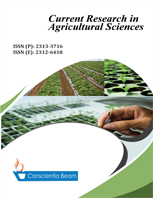Evaluation of Selected Botanical Extracts against Mendi Termite Macrotermes subhyalinus (Isoptera: Termitidae), under Laboratory Condition
DOI:
https://doi.org/10.18488/journal.68.2019.62.135.140Abstract
Termites are most pestiferous insects causing damage to crop and buildings. Their control still relies mainly on harmful chemical pesticides to the detriment of eco-friendly pesticides. The main objective of the study was evaluate seed extracts of Brassica nigra and leaves extracts of Acokantra schimperi, Croton macrostachyus and Rhamnus prinoides against Macrotermes subhyalinus, known to cause damage to crops, vegetation and buildings in Ethiopia. Treatments were consisted of three concentrations levels (5, 10 and 15 weight of botanical powder (g) per 100 ml volume of water) by three replications. Mortality of termite was counted after 24, 48 and 72 hours exposure for both conditions. The results of all botanical extracts at all concentration levels showed that caused mortality of M. subhyalinus workers. Complete mortality (100%) of M. subhyalinus was observed after treatment with 15 w/v B. nigra extract at three time intervals. Moreover, A. schimperi at 15 w/v concentration also resulted 100% mortality after 48-72 hours of exposure. Brassica nigra extract showed least LC50 (5.63g/100ml) value than other botanical extracts after 24 hours exposure. Based on their toxicity status extracts of B. nigra > A. schmperi > R. prinoides > C. macrostachyus leaf extracts.

